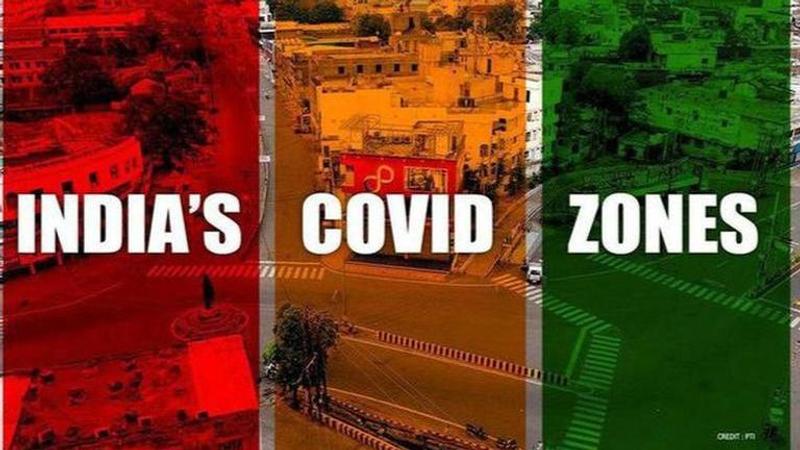Published 15:30 IST, May 3rd 2020
Lockdown 3.0: Here is what's allowed, what's prohibited in Green/ Red/ Orange zones
After the MHA announced its decision to extend the lockdown, the Centre has now issued a detailed set of guidelines regarding what is allowed or restricted

Advertisement
After the Ministry of Home Affairs (MHA) announced its decision to extend the nationwide COVID-19 lockdown for another two weeks, the Centre has now issued a detailed set of guidelines regarding what is allowed or restricted in Red, Orange and Green Zones.
Based on risk profiling, the government has divided areas into three zones which would be reviewed on a weekly basis. The Green Zones will be districts with either zero confirmed cases of COVID-19 to date or no confirmed case in the last 21 days. The classification of districts as Red Zones will take into account the total number of active cases, doubling rate of confirmed cases, the extent of testing and surveillance feedback from the districts. Orange Zones are the districts that are neither defined as 'green nor red zones'.
Here is list of activities prohibited throughout the country, irrespective of the zone
1. All domestic and international air travel of passengers, except for medical/security purposes or as permitted by MHA.
2. All passenger movement by trains, except for security purposes or for purposes as permitted by MHA.
3. All cinema halls, shopping malls, gymnasiums, sports complexes, swimming pools, entertainment parks, theatres, bars and auditoriums, assembly halls and similar places.
4. All social/political/sports/entertainment/academic cultural or religious functions/other gatherings.
5. Inter-state buses for public transport, or as permitted by the MHA.
6. Inter-state movement of individuals except for medical reasons, or as permitted by MHA.
7. All schools, colleges, education /training/-coaching institutions etc.
8. Hospitality services other than those used for housing, health/police/government officials/healthcare workers, stranded persons including tourists, and those used for quarantine facilities.
9. All religious places/places of worship for public.
Measures for well being and safety of persons
1. To be identified in red and orange zones.
2. No movement of persons allowed other than medical emergencies and supply of essential goods and services.
3. Aarogya Setu App compulsory for all residents of containment zones.
4. Movement of individuals for all non-essential activities strictly prohibited between 7 pm and 7 am.
5. Persons above 65 years of age, persons with co-morbidities, pregnant women and children below ten years to stay at home, except for essential requirements and health purposes.
6. OPDs and medical clinics permitted outside containment zones with social distancing norms and other precautions.
Red Zones - activities allowed with restrictions - outside containment zone
1. All industrial establishment in urban areas prohibited except: in Special Economic Zones/ industrial estates/townships with access control.
2. Manufacturing units of essential goods, including drugs, pharmaceuticals, medical devices, their raw material and intermediaries.
3. Production units requiring continuous process and their supply chain, jute industry with staggered shifts and social distancing.
4. Private offices can work with upto 33 per cent strength, rest to work from home.
5. All government offices with 100 per cent strength from levels of deputy secretary and above, remaining to attend up to 33 per cent.
6. Defence and security services, health and family welfare, police, home guards, fire and emergency services and such other important services to function without restrictions.
7. Movement of individuals and vehicles only for permitted activities vehicular restriction -- four-wheelers to have maximum two passengers besides driver and pillion rider not allowed for two-wheelers.
8. All construction activities in urban areas prohibited, except: a) in situ construction, and b) construction of renewable energy projects.
9. All shops selling essential goods to remain open in red zones, except in malls.
10. All shops selling non-essential goods to remain closed in malls, market complexes and markets in urban areas.
11. All stand-alone shops, neighbourhood (colony) shops and shops in residential complexes to remain open in urban areas for essential and non-essential goods.
12. All shops in rural areas (other than mills) to remain open for essential and non-essential goods e-commerce activities only in essential goods.
Moreover, activities prohibited across the country will be prohibited in red zones. Cycle and autorickshaws, taxis and cab aggregators, intra-district and inter-district plying of buses and barber shops spas and saloons are also prohibited.
Green Zones
In the green zones, all activities are permitted except the limited number of activities which are prohibited throughout the country, irrespective of the zone. However, buses can operate with upto 50 per cent seating capacity and bus depots can operate with upto 50 per cent capacity.
Orange Zone activities prohibited/allowed with restrictions - outside containment zones
All activities are permitted except the following:
1. Activities prohibited throughout the country.
2. Inter-District and Intra-District plying of buses.
3. Taxis and cab aggregator permitted with one driver and 2 passengers.
4. 4 wheeler vehicles allowed with maximum of 2 passengers and 1 driver.
National directives for public places
1. Marriage related gatherings shall ensure social distancing, guests not more than 50.
2. Funeral, last rites to ensure social distancing not more than 20 people allowed.
3. Wearing face cover compulsory, ensure social distancing.
4. Gathering of more than 5 people not allowed in public places.
5. Spitting in public places punishable offence.
National directives in workplaces
1. Ensure social distancing in company transport.
2. Face cover compulsory.
3. Thermal scanning, handwash, sanitiser at workplaces.
4. Adequate gaps between shifts, staggered lunch break.
5. Frequent sanitisation of the entire workplace.
6. Large physical meetings to be avoided.
7. Hospital/clinics authorised to treat COVID-19 patients should be identified at nearby locations, a list should be available at the workplace at all times.
8. Intensive communication, training on good hygiene practices.
9. Aarogya Setu Mobile App mandatory for all employees and heads of offices to ensure compliance.
(ANI Inputs)
15:30 IST, May 3rd 2020




